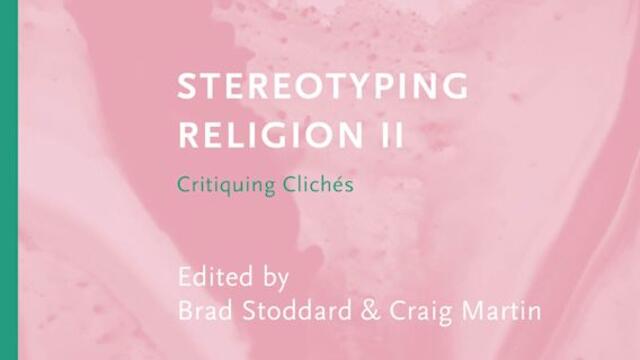Faculty expert’s new anthology confronts clichés in religion
Associate Professor Brad Stoddard was inspired by input from students in his courses at McDaniel College to co-edit a new anthology of essays addressing modern stereotypes on religion, “Stereotyping Religion: Critiquing Clichés Volume II.”

"Stereotyping Religion II: Critiquing Clichés," published by Bloomsbury Publishing in 2023.
In the recently published “Stereotyping Religion: Critiquing Clichés Volume II,” editor and Associate Professor of Religious Studies and History Brad Stoddard, along with co-editor Craig Martin, aim to address common clichés about religion and use them as a springboard into critical studies of religion, politics, history, and language.

“This book was literally born in McDaniel College classrooms,” Stoddard says.
In his courses on religious studies, Stoddard noticed that while clichés about religion from older generations were resonating with his students, they weren’t the ones they were most familiar with in their everyday lives. Instead, they had new ones to share with him.
“Just from talking to students in McDaniel College classrooms, I learned that there were new common clichés on religion circulating in their generation. So, I asked the students, ‘What clichés do you hear?’”
He saw this trend as an opportunity to create volume two of “Stereotyping Religion.” Stoddard and co-editor Craig Martin, professor of Religious Studies at St. Thomas Aquinas College, published the first volume in 2017. While the clichés in volume one remain relevant, it’s the nature of religious studies to observe changes in how society views religion, Stoddard says.
“Clichés are evolving because culture evolves, because politics evolve, because generations evolve, religion evolves,” he says. “The political climate is different now than it was less than a decade ago, and a lot of issues, like sexuality, politics, and religion, are important to students in new ways.”
It was clear to Stoddard that what undergraduates were sharing with him represented significant shifts in the younger generation’s perspectives on religion. With Martin on board, they sought out scholars to address a list of 10 new clichés.
“Stereotyping Religion: Critiquing Clichés Volume II,” published by Bloomsbury, defines a cliché in each chapter and pairs it with an essay from a scholar with subject-matter expertise.
Clichés in the volume include “Eastern religions are more spiritual than Western religions,” “all religions are against LGBTQ rights,” and “religion is personal and not subject to government regulation.”
“We wanted to make it balanced across the political and ideological spectrum,” Stoddard says. “We’re pointing out that people are not always as coherent thinkers as we’d like to think we are.”
Stoddard and Craig also co-authored an essay in the anthology titled “Spirituality is about spirituality.” They explore the meaning of someone claiming to be spiritual, but not religious. By exploring the motivations behind that claim and the origins of the terms “spiritual” and “religious,” they delve into complex topics like taxonomy — how people label things.
They arrive at the conclusion that there is little difference between people who say they are only spiritual versus those who say they are religious, besides a desire to not be associated with organized religion. “It really speaks to the individualism that’s important to this generation,” Stoddard says.
By leading with clichés, Stoddard says, the anthology as a whole can avoid normalizing misconceptions and instead approach them with new perspective.
Making the anthology easily readable, with accessible language for undergraduate students, was also critically important to the co-editors.
“We were thinking of that every step of the way,” he says. “We wanted zero jargon and to be completely accessible, with examples that will engage a student. We wanted to speak to them where they’re at, so we could have the intellectual heavy lifting in the background.”
The approachability of the anthology ties into Stoddard’s goal of generating practical conversations about “the two things you’re not supposed to talk about in public: religion and politics,” he says. “We’ve got to find novel ways to engage in these conversations productively, so we can engage in two of the most important things in our lives.”